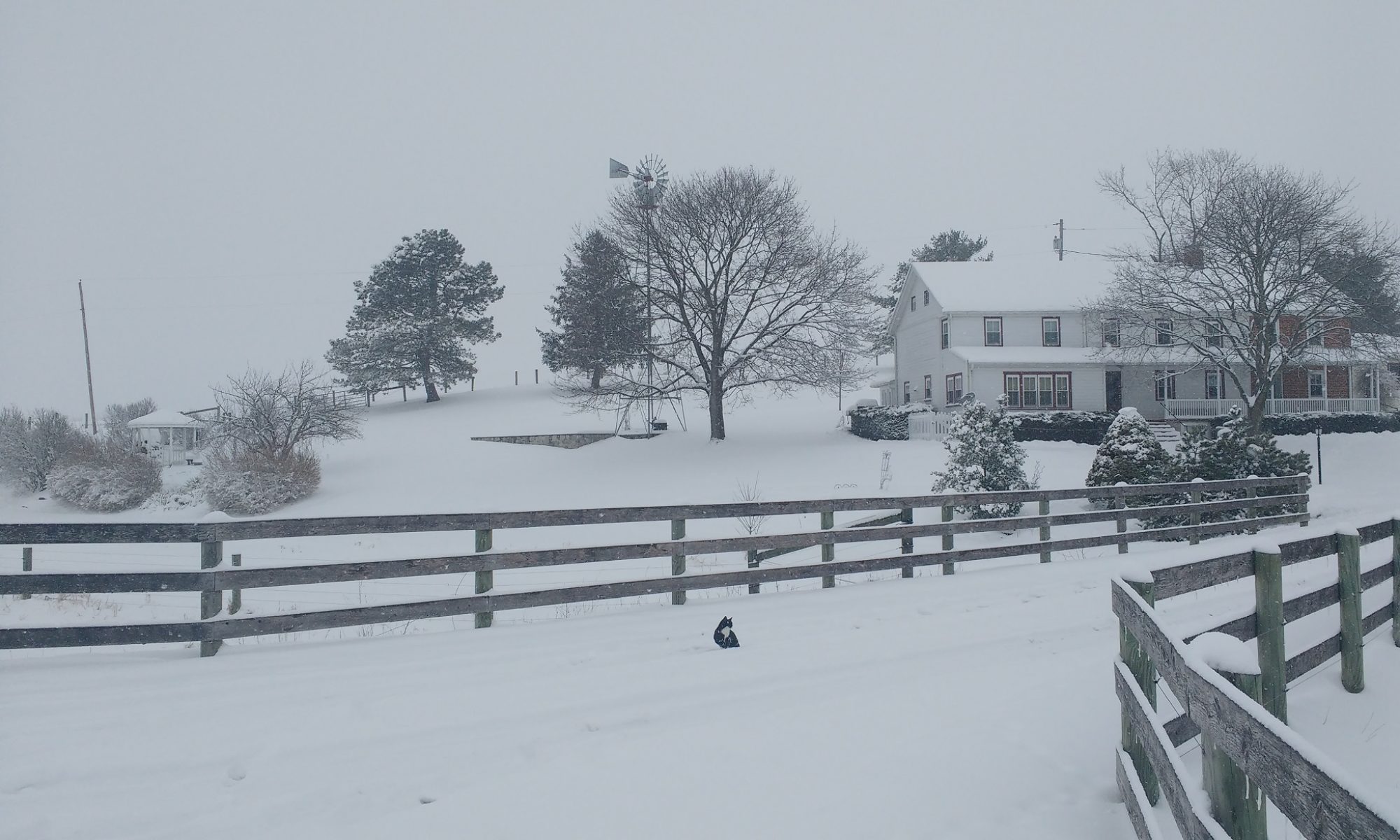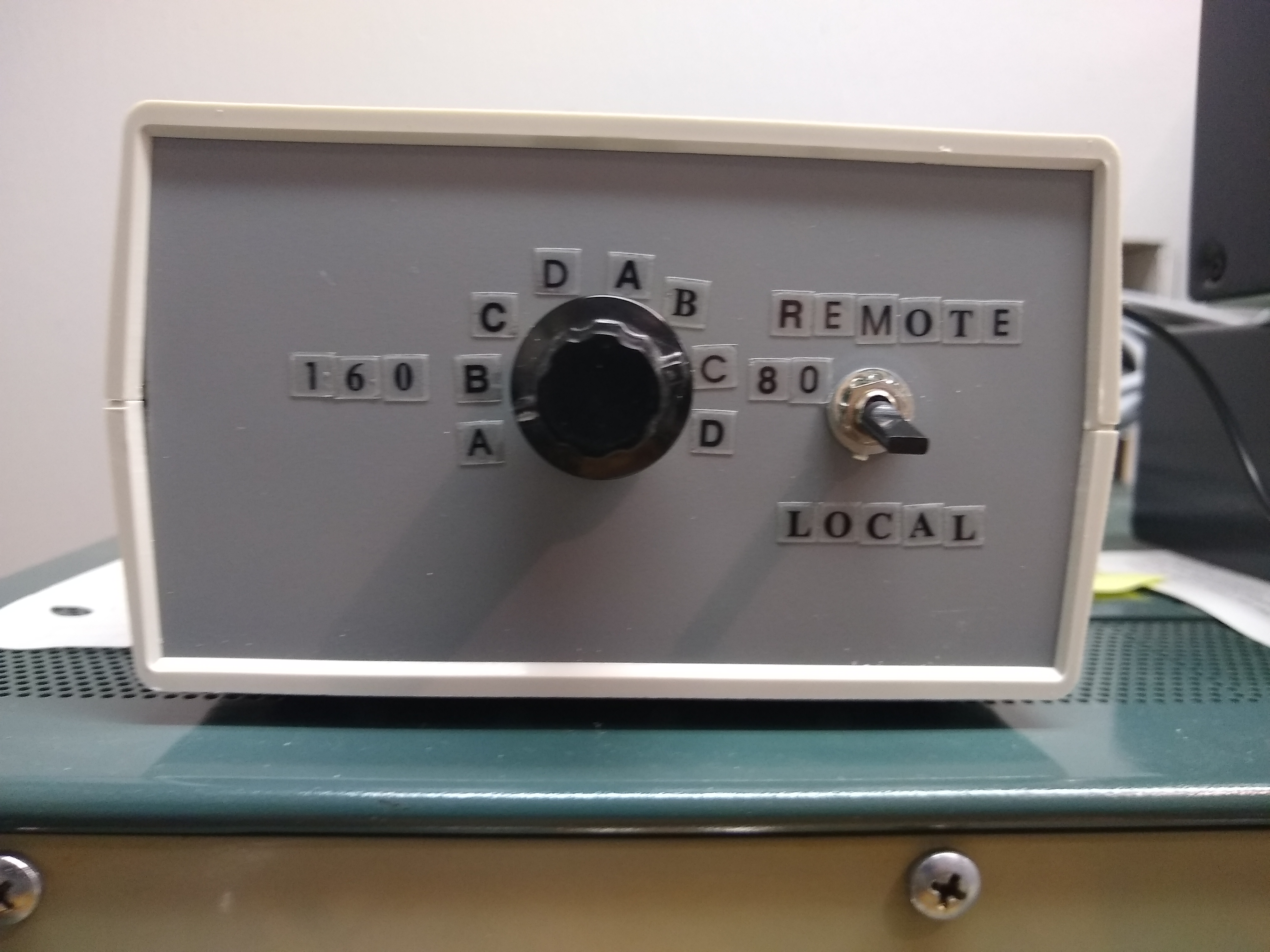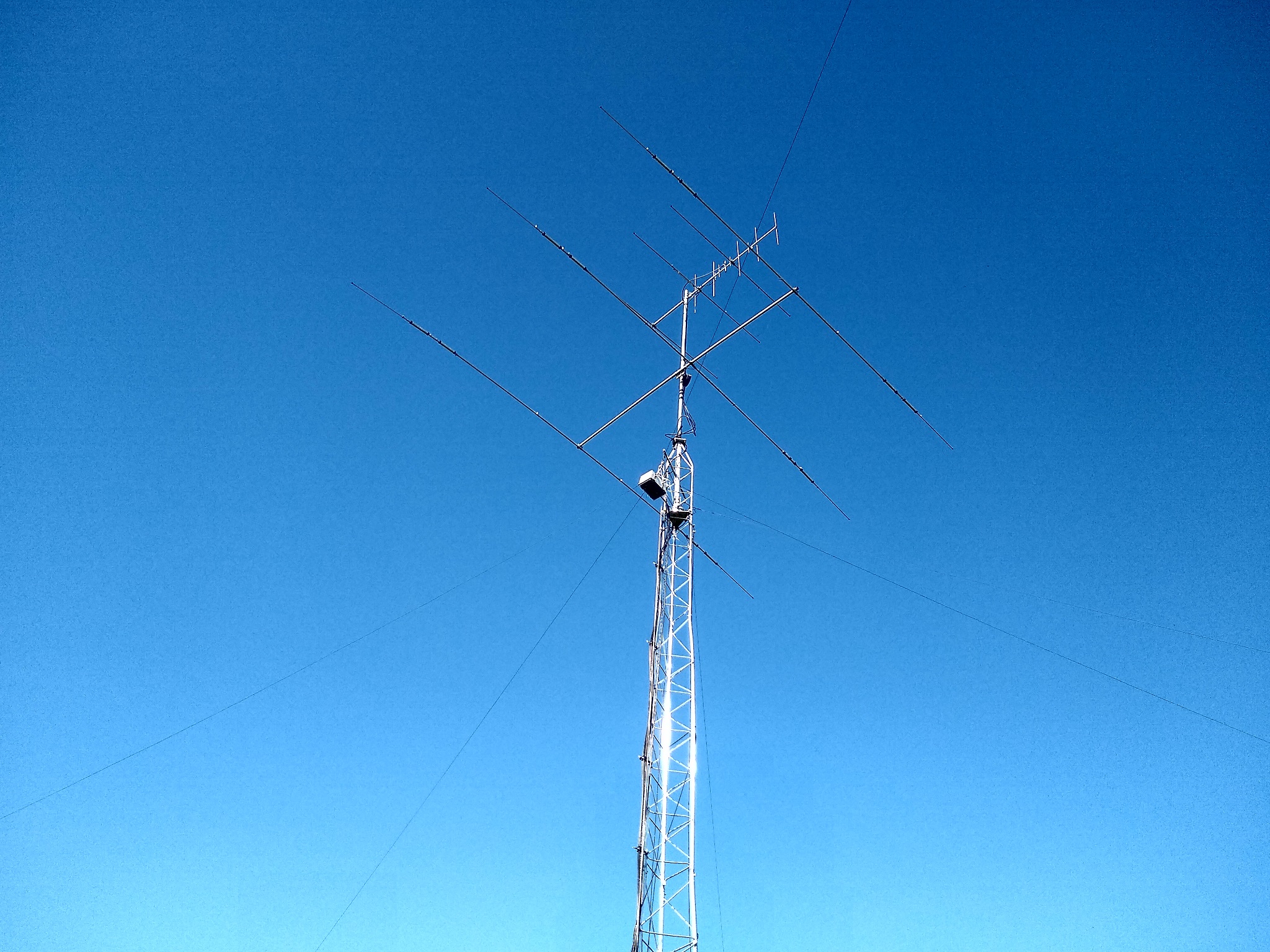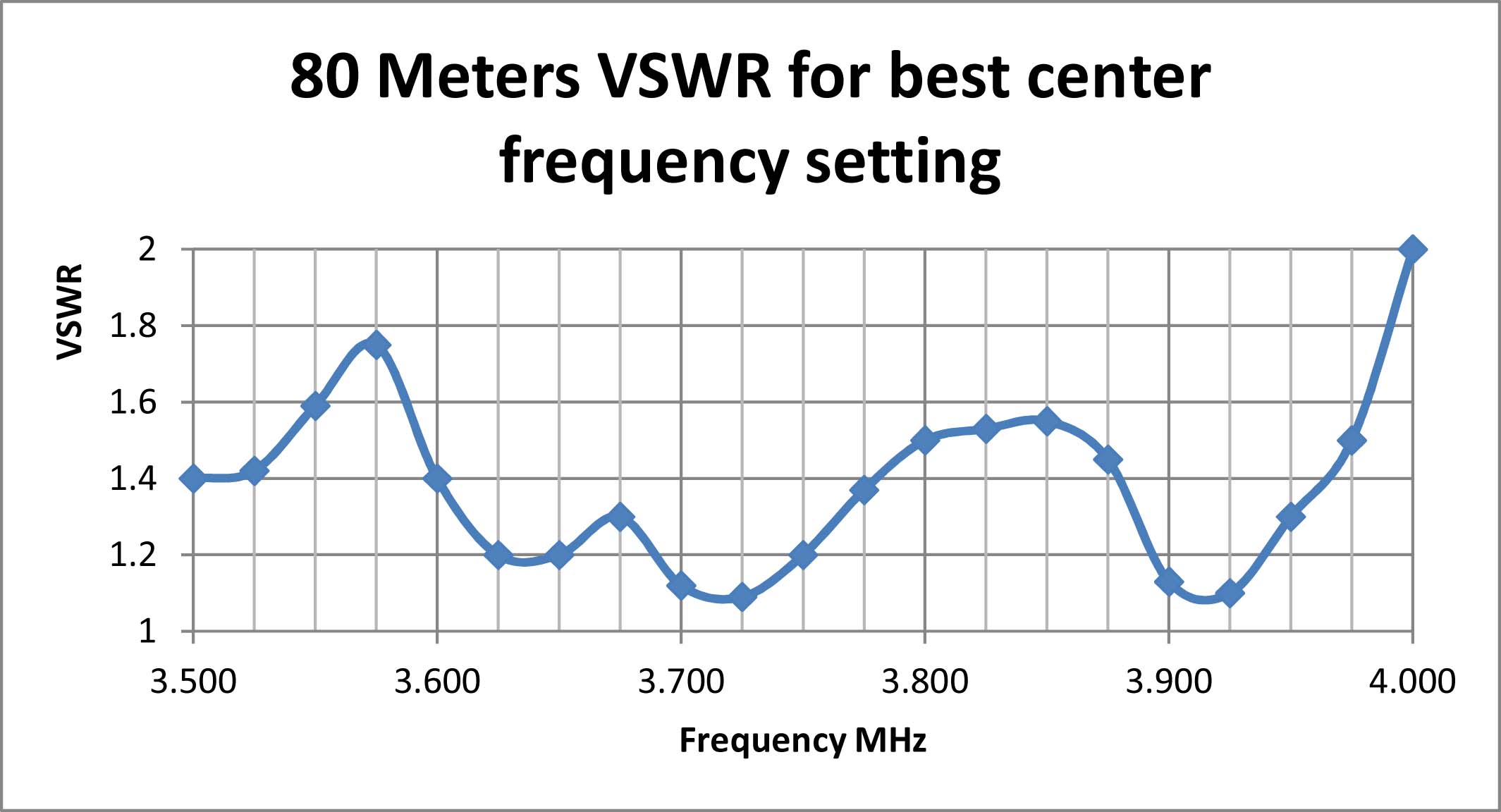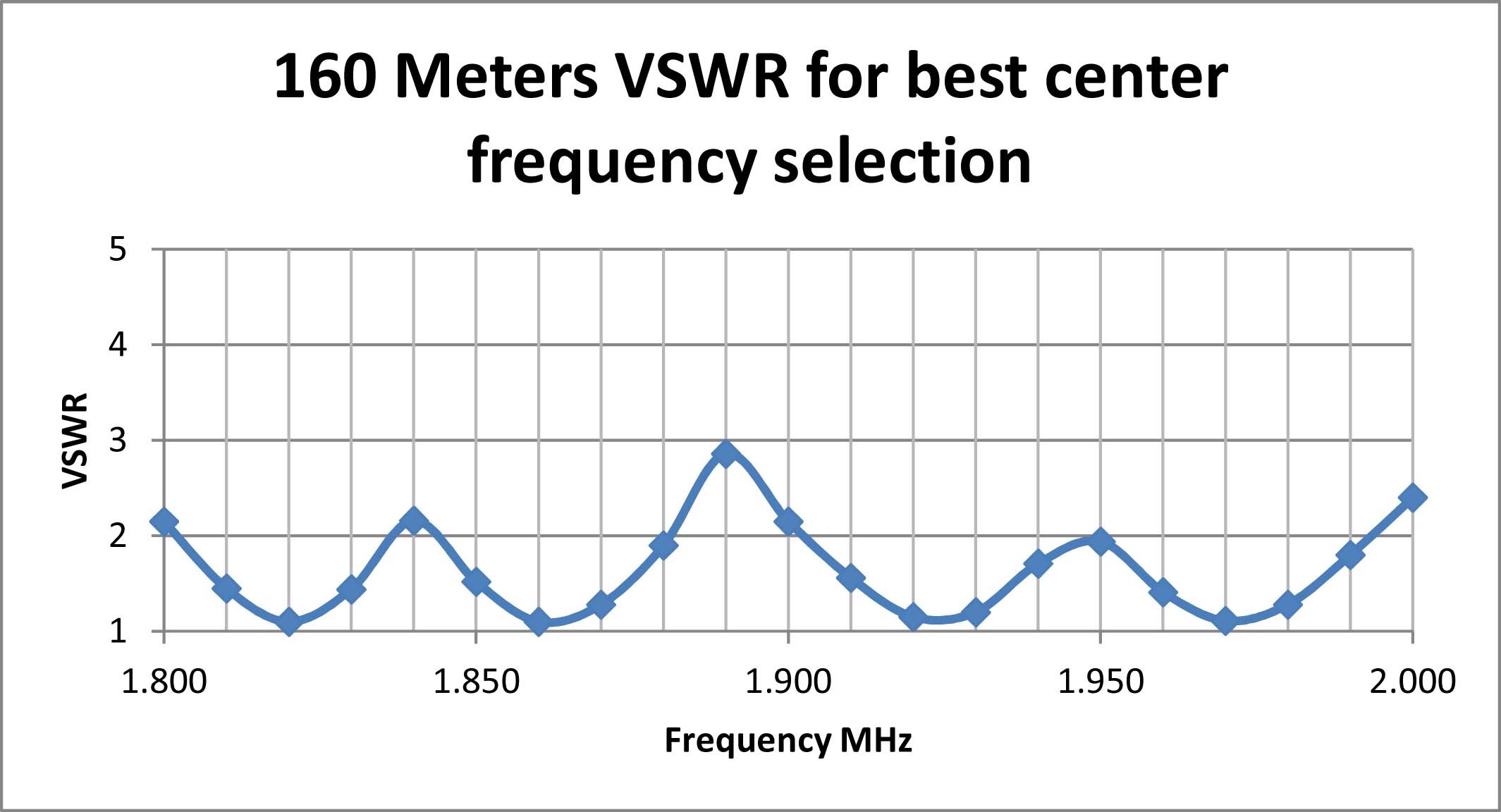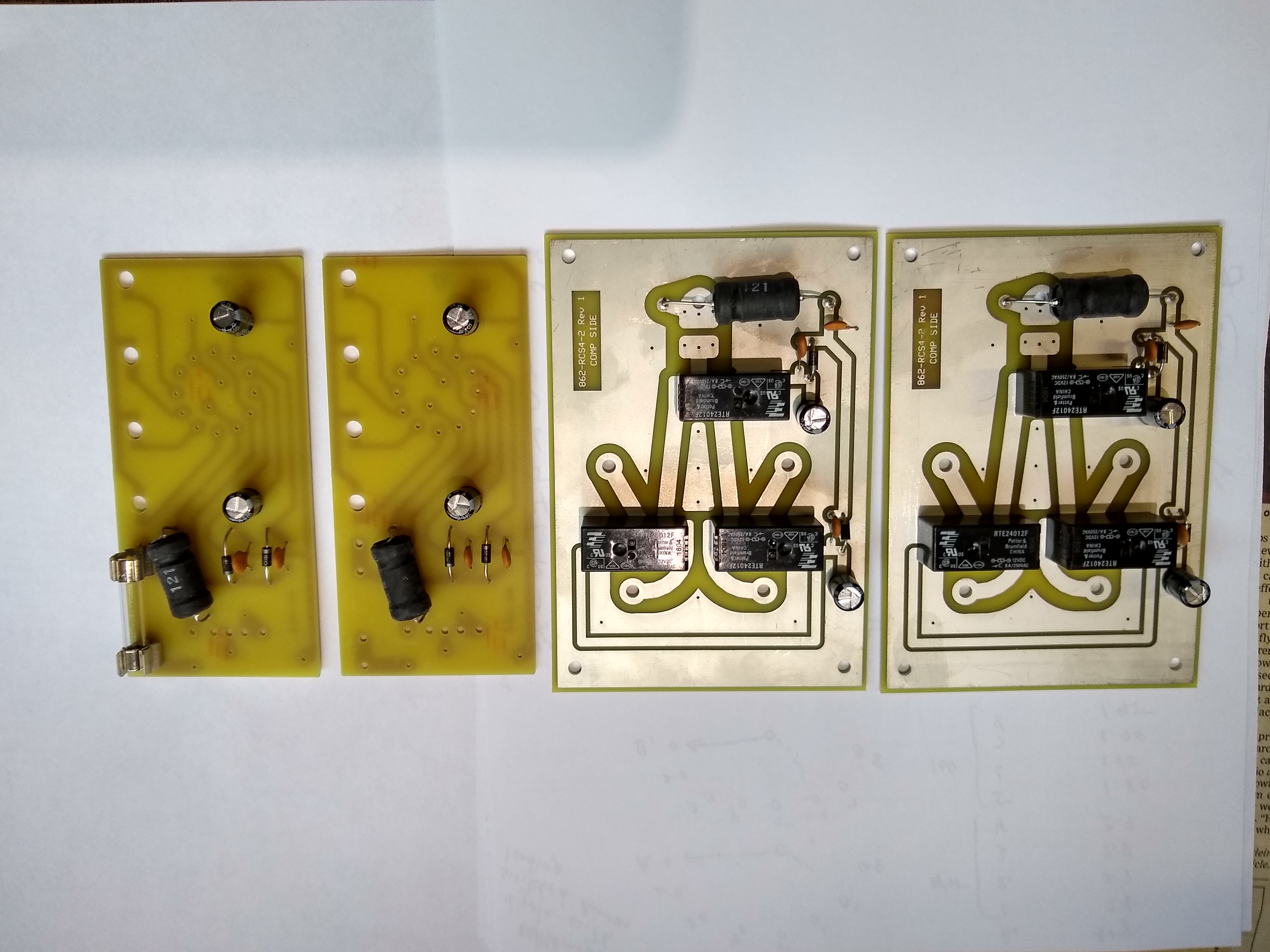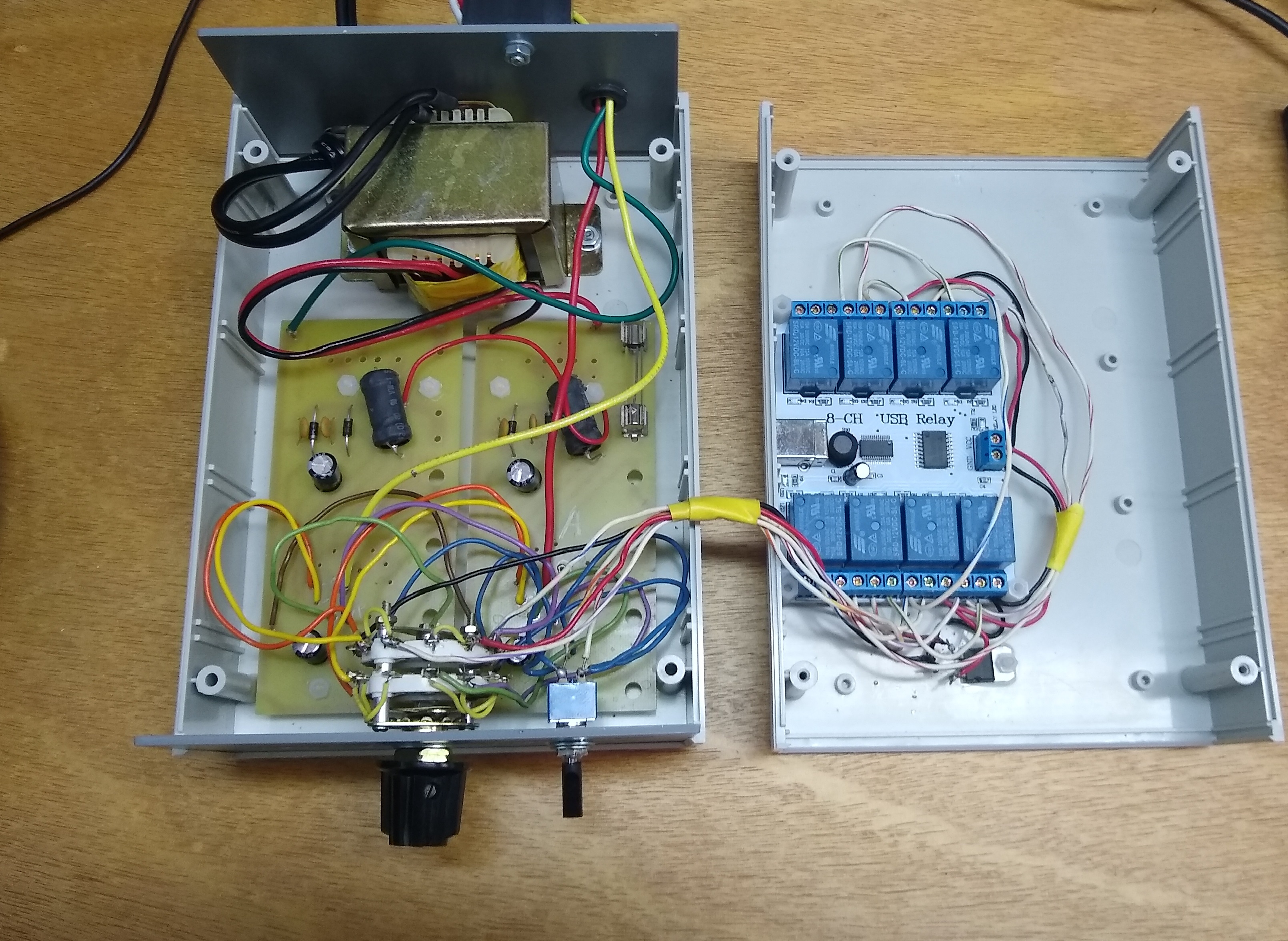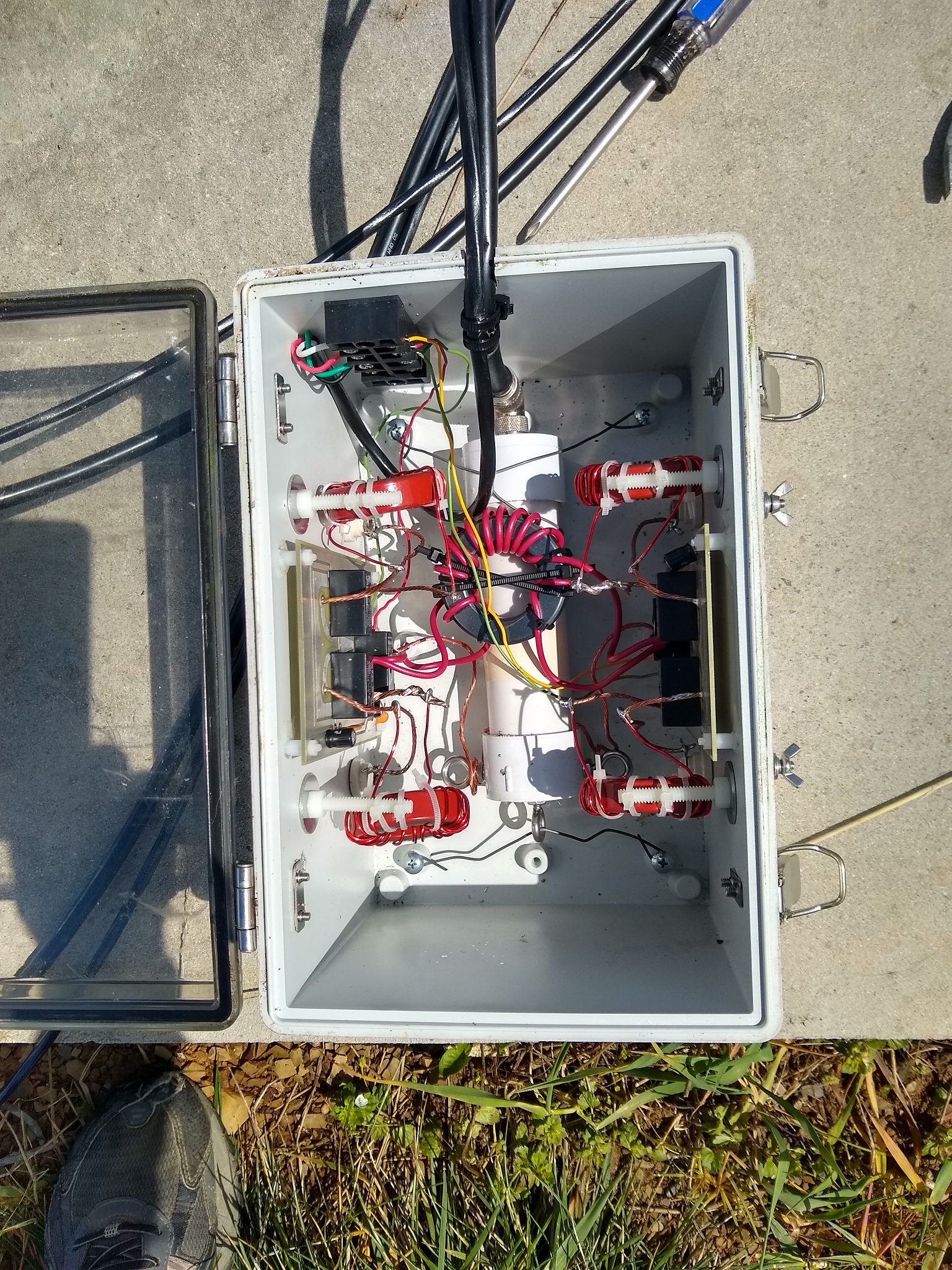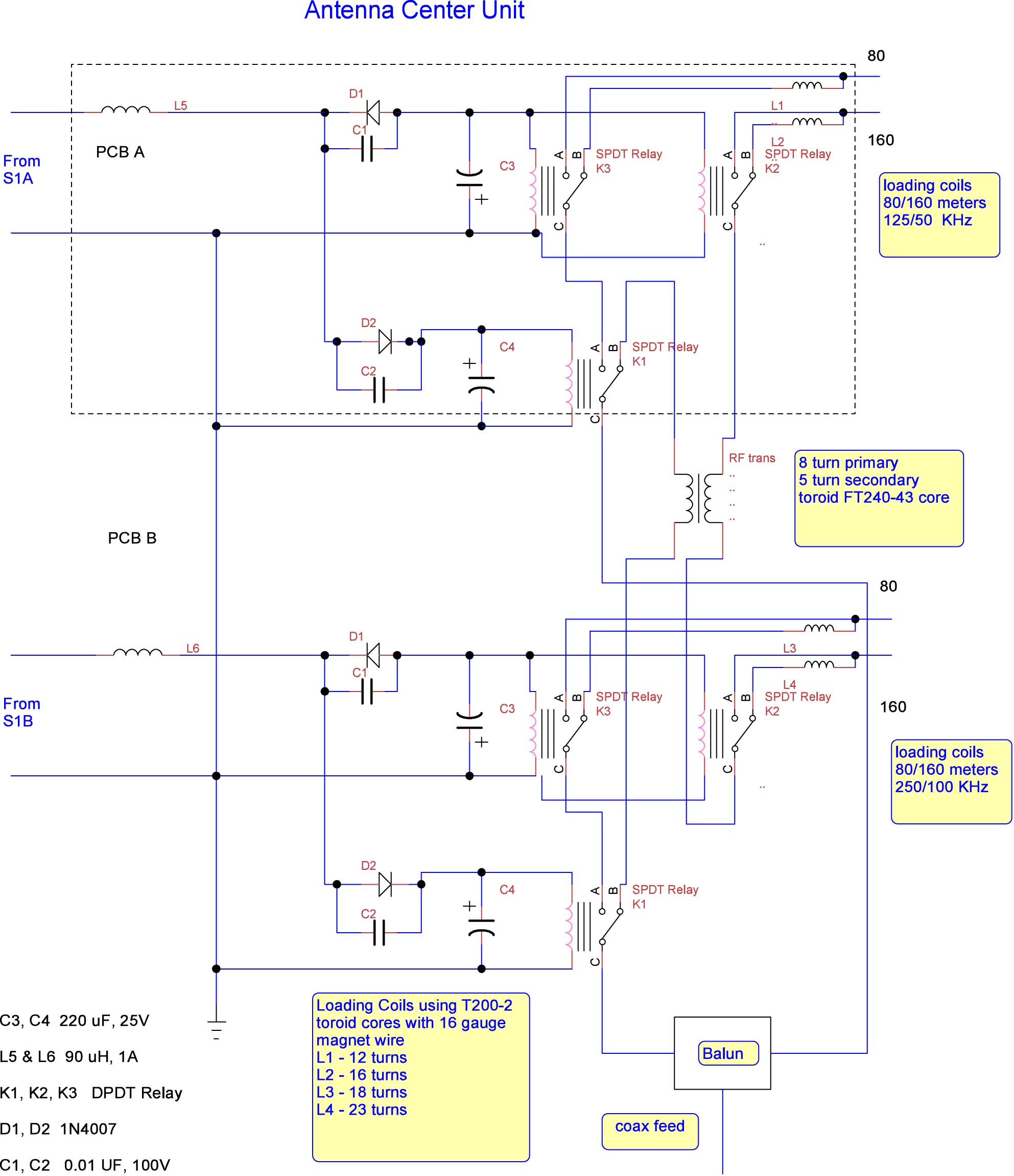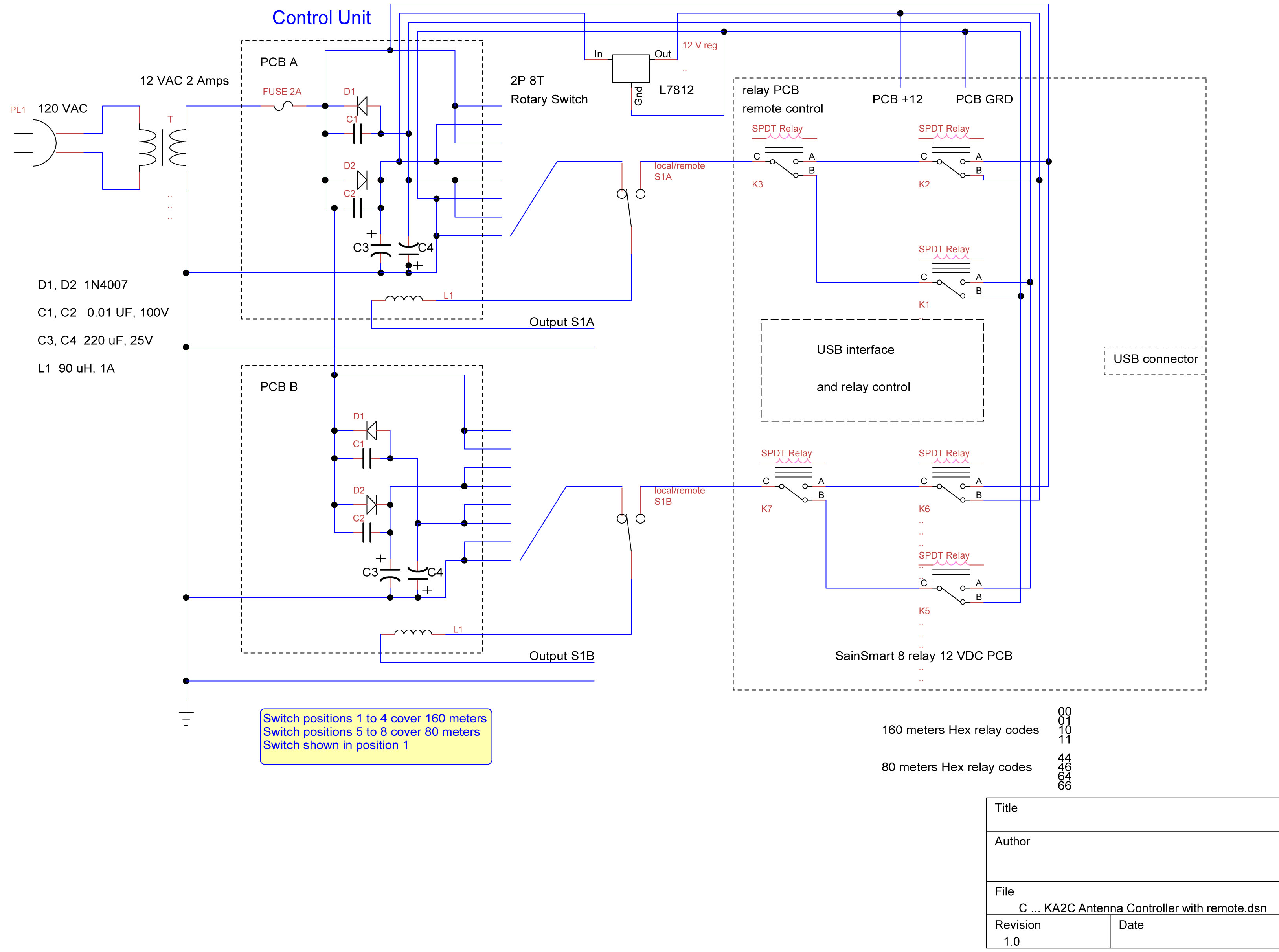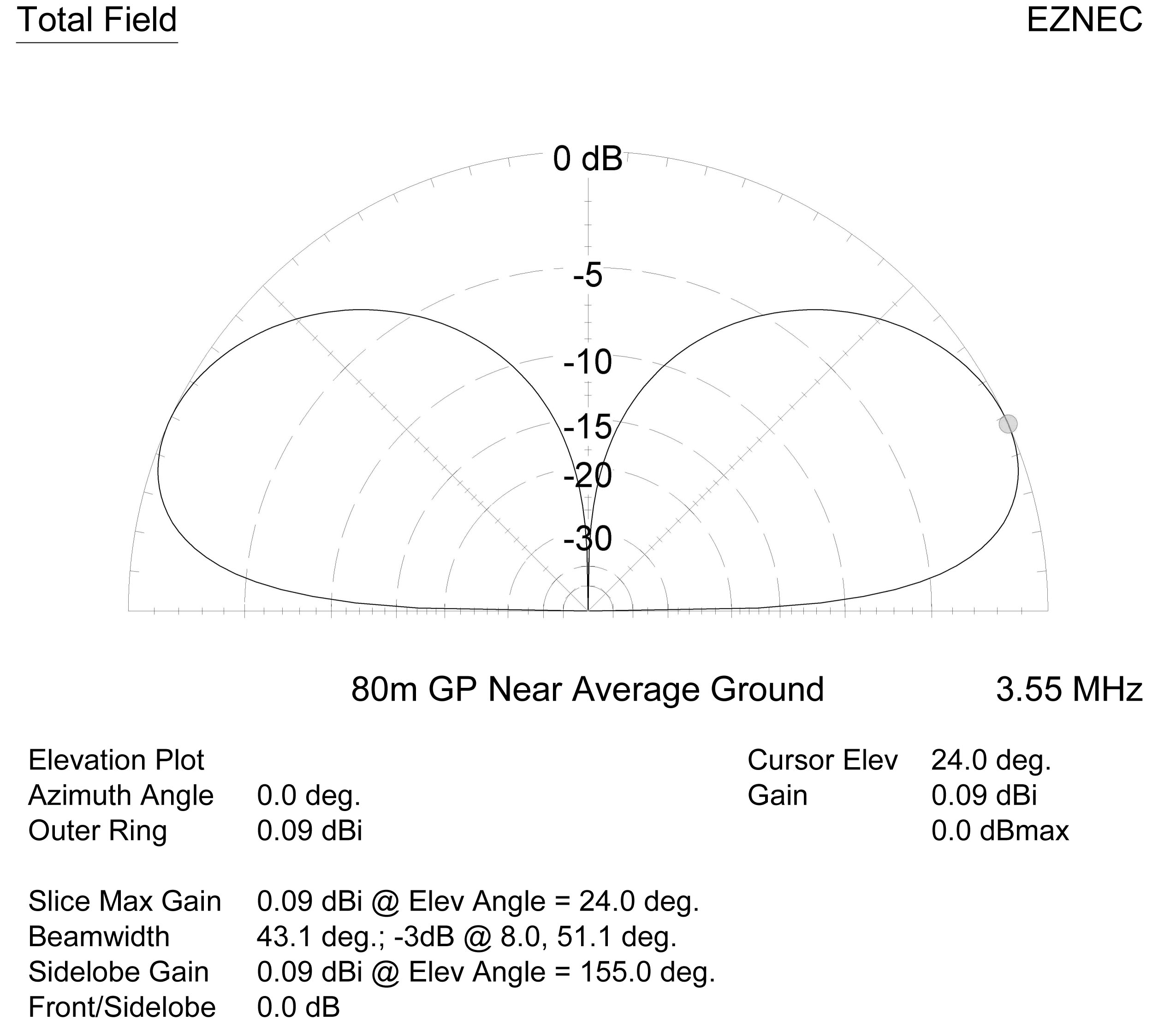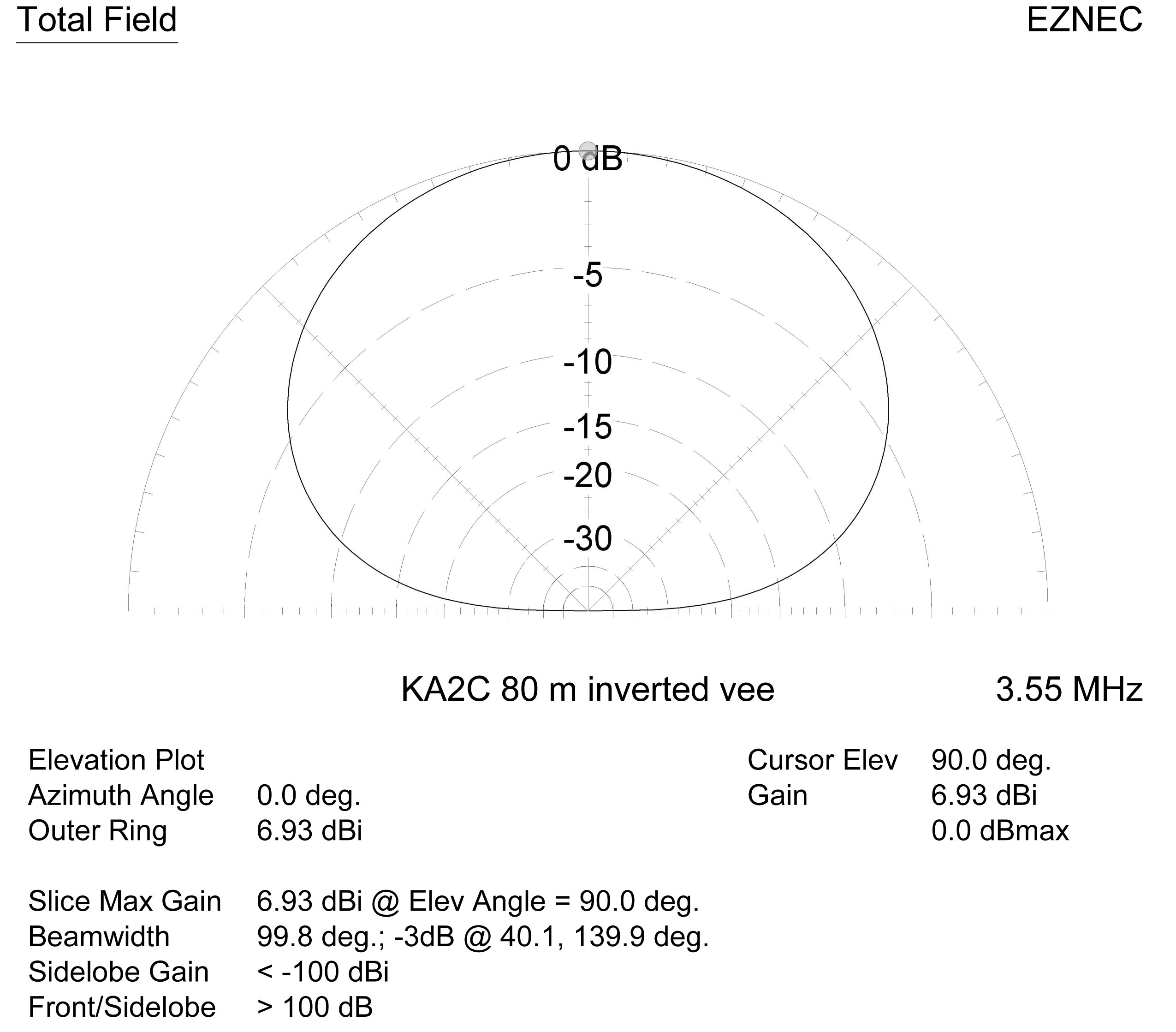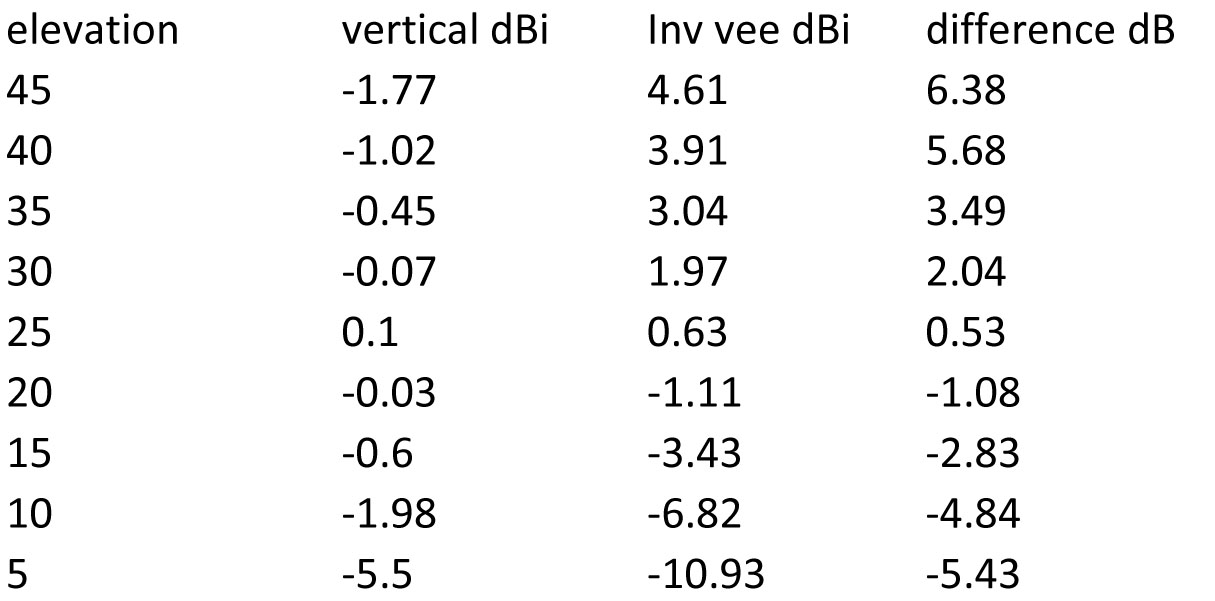KA2C Antenna
Kilowatt Antenna for 2 bands with switched Center frequency
This antenna project was motivated by the desire for a single inverted vee antenna to cover the full 160 and 80 meters bands with low VSWR, preferably below 2:1 across the entire bands. Goals included: 1) full band coverage; 2) sufficiently low VSWR to support typical modern ATU’s built into transceivers limited to about 3:1 VSWR or vintage tube rigs without requiring external wideband antenna tuners; 3) good efficiency and performance; 4) support for the full legal limit power of 1500 watts; 5) simple construction; 6) remote operation; and 7) low cost. An inverted vee antenna was preferred to allow the use of a single tall support at about 40 feet using a tower also supporting Yagi antennas on 20/15/10 meters and VHF/UHF bands. The tower also supported an inverted vee antenna on 40 meters that easily covered the entire band at less than 2:1 VSWR.
An inverted vee antenna tends to slightly reduce the bandwidth of the antenna compared to a dipole, which meant achieving 2:1 VSWR across the 80 & 160 meters band was even harder. Various sources showed that a 2:1 VSWR might only be achieved over about 150 KHz on 80 meters with an inverted vee, and that the extremes of the band might exceed a 10:1 VSWR. After exploring a number of existing approaches, I was interested in the idea of using switching relays at the antenna legs center to switch the antenna center frequency in perhaps 4 steps across each band and between 160 and 80 meters elements, so that a single coaxial feed would fully cover 160 and 80 meters with low VSWR.
An investigation of sources on antenna design did not yield much information on this approach, but I did find a few special cases that are relevant. Array Solutions and JK Antennas both mention a similar method using small switched inductors for 80 meter Yagi’s where it is no doubt particularly painful to build such a large and expensive Yagi only to cover a limited part of the band. ON4UN discusses this method in his book “Low-Band DXing” also for large 80 meter Yagi’s in Chapter 13. SteppIR uses relays and loading elements on Yagi’s to select the direction of the antenna for 40 meters and up, and they also have a remotely switched loading coil for coverage of 80 and 60 meters with verticals. Clearly such methods are desirable for high-end and high-performance antennas. The KA2C design uses a similar method for a low-cost solution for inverted vee’s and dipoles for 80 and 160 meters using toroid inductors.
This picture shows the front panel of the KA2C antenna control unit. A toggle switch selects either local or remote control. An 8-position rotary switch selects 1 of 4 band segments from the bottom to the top of the band on 160 meters and 1 of 4 band segments similarly from the bottom to the top of the band on 80 meters. The remote control connects to a local PC with a USB cable and utilizes a SainSmart 8-relay USB PCB available on Amazon. Remote operation is then possible using Teamviewer.
The antenna contains separate radiating legs for 160 and 80 meters that are at about 90 degree angles to each other to minimize coupling, and they are cut for the top frequency segment of each band. Toroid inductors are switched into the center fed points of the legs to shift the antenna center frequency down in about 125 KHz steps for 80 meters and about 50 KHz steps for 160 meters with 4 center frequency settings per band. Since the antenna is “full size” or nearly “full size” with small loading elements, the expectation was performance very near to “full size” with low VSWR across the entire bands
The 80 meters and 160 meters antenna legs converge on the antenna center unit (the box just below the top of the tower and to the left) which can be raised and lowered with a rope and pulley. Each antenna element end is supported by a 16 foot tall 2″ x 6″ with a pulley and rope to allow easy lowering and raising of the end of the element for tuning.
The VSWR results for 80 meters are excellent with 90% of the band at less than 1.5 and the VSWR rising to about 2.0 at the top of the band.
The VSWR results for 160 meters are acceptable with about 90% of the band at less than 2.5 and rising to 3.0 near the center of the band.
Operation of the antenna is quite simple and fast. A control unit has an 8 position rotary switch as well as remote control. The first 4 positions cover 160 meters in about 50 KHz steps and the second 4 positions cover 80 meters in about 125 KHz steps. The segments are wide enough that usually a band segment can be pre-selected for operations and not touched. For example, the CW, data and DX portions of the bands (lower segments) are covered by the first segment of each band. The remaining segments provide full band coverage for phone operations and the appropriate segment is easily pre-selected in seconds.
Available remote antenna switching relay systems are intended to switch coax feed lines (not the individual legs of an inverted vee). It would be possible to use 2 such systems with each providing 4 possible independent connections, and then interfacing the switched coax connections to the legs and loading elements and interfacing the common connection to a balun in the center of the antenna system. However, from a control point of view this is not convenient, because only 80 meters antenna legs should be used together and only 160 meters antenna legs should be used together. It is also observed that there at 8 possible total antenna center frequency selections; 4 center frequencies on 160 meters and 4 center frequencies on 80 meters.
It appeared desirable to have a single rotary switch with 8 positions to select the band and the center frequency within each band for simplicity for local control. It also seemed desirable to have a single control box supporting local and remote control and a single center unit feed box for the antenna system, so a decision was made to custom build these units. However, Ameritron, a provider of remote antenna relay switch systems, sells PCB’s and components for these systems (this may no longer be the case after Ameritron was acquired by MFJ). A review of the architecture and components available for the RCS-4 remote antenna switch system showed that much of these units could be used effectively for the proposed system.
The KA2C system was designed using 2 control PCB’s, a SainSmart 8-relay USB PCB, and 2 remote PCB’s supporting 1:4 antenna switching with 3 relays per remote PCB from the RCS-4 system. Instead of switching coax feed lines, the remote PCB’s would be used to switch different antenna legs and toroid loading coils on each side of a balun. The 2 control PCB’s were mounted in a single control box along with a shared 12 VAC transformer; a shared 2 pole and 8 position rotary switch; and a toggle switch to select remote/local operation. The SainSmart 8-relay USB PCB is mounted on the top cover of the control box with 6 connecting wires to the rest of the control box. An L7812 voltage regulator is used to feed the SainSmart PCB since it has sensitive electronics, and the raw power supplies output actual voltages of 17 volts or higher on the +- 12 VDC rails. The RCS-4 system was designed for control over the coaxial cable. The control box sets one of 4 states on the coax added to the RF: 1) no added voltage; 2) negative 12 VDC; 3) positive 12 VDC; or 4) 12 VAC (60 Hz). However, 2 control signals are needed in the KA2C system, so a dedicated 4-wire control cable was added to the system, and the control signals are sent directly between the control box and the remote switch box and are not added to the single coax RF signal. The 2 remote PCB’s were mounted in a water proof box with a balun and 8 RF feed connections and a terminal strip to connect the control cable. The control cable and feed coax are bundled together from the antenna center unit to the radio shack where they separate to the coax switching/distribution system and the KA2C antenna control box.
The 2 control PCB’s and 2 remote PCB’s with relays are shown with components mounted.
The open control box is shown with the 2 control PCB’s, a 12 VAC transformer, a 2 pole 8 position switch and a toggle switch to the left. The 8-relay USB PCB is mounted in the top cover along with a 12 VDC regulator to the right.
The antenna center unit is shown with a balun in the center of the box. Mounted on top of the balun is a toroid RF transformer for 160 meters only on an FT240-43 core with 8 turns on the primary and 5 turns on the secondary. The 4 toroid loading coils are visible also. The 2 remote PCB’s with switching relays are mounted on opposite sides of the box and each PCB connects to 4 antenna feed points for each antenna leg. For each PCB there are: 1) 160 meters direct feed; 2) 160 meters feed with loading; 3) 80 meters direct feed; and 4) 80 meters feed with loading. One PCB switches IN/OUT 125/50 KHz frequency shift toroid coils for 160/80 meters respectively for a first side of the inverted vee, and the other PCB switched IN/OUT 250/100 KHz frequency shift toroid coils for 160/80 meters respectively for a second side of the inverted vee. Next to each PCB, 2 large ceramic feed throughs can be seen to connect to the antenna legs. With the inverted vee center point at only about 38 feet above ground level, the impedance at resonance of the antenna on 160 meters is only about 20 ohms, so the RF transformer provides a match to 50 ohms. For 80 meters, the impedance match is excellent with a direct connection to the balun.
The KA2C antenna center unit schematic shows that 3 relays are needed for each side of the inverted vee or 6 total. A first relay on each antenna leg is used to select between 160 and 80 meters antenna legs, and a second stage of relays (one each for 160 and 80 meters per leg) selects between direct or loaded connections to each leg.
The KA2C antenna control unit schematic shows a very simple design using 2 PCB’s with a small number of components, a 12VAC transformer and a 2 pole 8 position rotary switch, a toggle switch, the SainSmart PCB and a 12VDC voltage regulator. The control PCB’s, remote PCB’s, switching relays and other components are available from Ameritron. Other components including the rotary switch are readily found on Ebay, and the boxes for the control unit and the antenna center unit were obtained from Allied Electronics; part number PC-11468 was used for the control unit and part number PTH-22426-C which was designed for weather proof operation was used for the antenna center unit. The SainSmart 8-relay USB PCB and the 12 VDC regulator were purchased on Amazon. The RF toroids were obtained from KitsAndParts.
EZNEC antenna analysis
EZNEC analysis of the radiation of a ground plane vertical and the KA2C inverted vee with the center point at 40 feet above ground are shown here. As is well known, the vertical does well for low elevation angle radiation which is important for DX. However, the inverted vee’s main lobe (which is straight up) has almost 7 dB of gain over an isotropic source (about 5 dB compared to a dipole), but the vertical is just about at 0 dBi at the peak radiation point near 20 degrees of elevation. This is important when viewing the differences in gain between the antennas.
For local and mid-range communications, the inverted vee antena has 6 dB of advantage for angles at 45 degrees and higher. The inverted vee performs as well as the vertical in the 20 to 25 degree elevation range (this is in the main or broadside azimuth angle for the inverted vee which is a bit lower off the ends depending on the elevation angle). From 15 to about 33 degrees elevation, the 2 antennas are within 3 dB or 1/2 of an S unit of each other. However, at very low angles of 5 to 10 degrees, the vertical is 4.5 to 5.5 dB stronger than the inverted vee and this is approaching 1 S unit of signal difference.
For the best DX performance, clearly a good vertical or vertical array has advantages over a low dipole or inverted vee like the KA2C antenna. However, the inverted vee’s simple structure and general purpose capability providing full band coverage with the switched loading feature and its suitability for local and DX contact situations may also be attractive.
For DX operations, the use of a linear can help offset the low angle radiation limitations for the KA2C inverted vee for transmit. But for receive, the antenna favors strong local and mid-range stations. It would be attractive to use a separate receive only antenna such as a pennant, flag or K9AY loop antenna in conjunction with the KA2C inverted vee for transmit.
Discussion
The antenna system works very well in terms of full band coverage, low VSWR across the bands, requiring only a single tall support shared with other antennas, simplicity,….. It does take some significant real estate which is not possible for many hams, especially for 160 meters. The use of a higher tower would be desirable with this system, especially for 160 meters.
An 80 meters only inverted vee with 4 selected center frequencies would be substantially simpler and have much lower real estate requirements. It would only need 1 relay per antenna leg and could use control over the RF coax feed line with 4 states: 1) off; 2) -12V; 3) +12V; and 4) 12VAC. This would provide a simple and low-cost method to fully cover 80 meters with a full size and resonant antenna with well under 2:1 VSWR across the entire band.
Some study on Off Center Fed Dipoles (OCFD) showed an interesting characteristic which was a consideration in the design of this antenna system. Small offsets in the feed point placement of a dipole near the center point causes very small changes in impedance.
Rr=75 Ω / sin2 (2xπ/λ)
Where:
- X is the distance from the end of the dipole, and
- λ is the wavelength (twice the length of the dipole).
The sine function changes slowly around pi/2, and (sin)2 also changes slowly around pi/2 which is the core factor in this formula. For example, a 10% change in the offset of the feed point, only changes the antenna impedance by 2.5%. This means that it is possible to add small/modest length to a dipole or inverted vee on one side only of the center feed point to change the center frequency while having negligible impact on the antenna impedance.
This characteristic lends itself to providing unlike loading elements on the 2 sides of a dipole or inverted vee which could also be switched IN/OUT of the system independently to change the center frequency. For example, if a first loading element on a first side of an 80 meters inverted vee when switched in to the system lowers the center frequency about 125 KHz, and a second loading element on a second side when switched in to the system lowers the center frequency about 250 KHz, then when both elements are switched in to the system, you expect the center frequency to be lowered about 375 KHz. This appears then as a 2-bit binary counter for control of the center frequency of the inverted vee corresponding to 4 possible center frequencies spaced across the band. This is approximate, since the required loading is a function of frequency.
